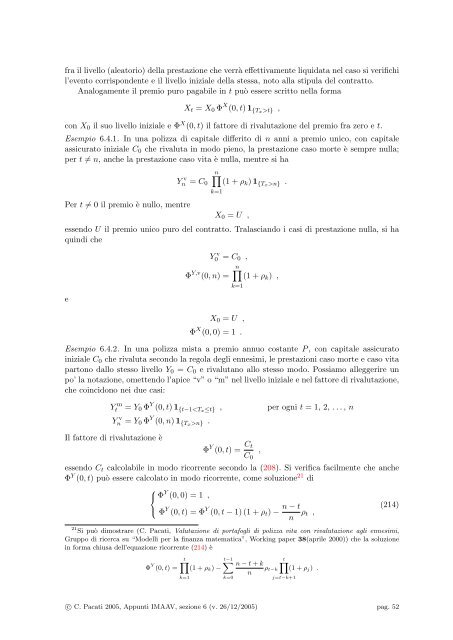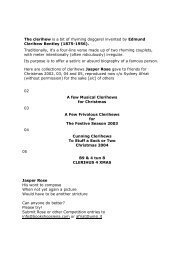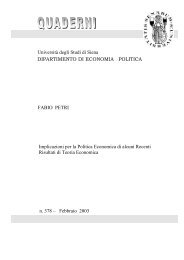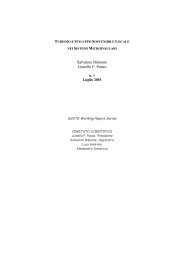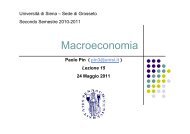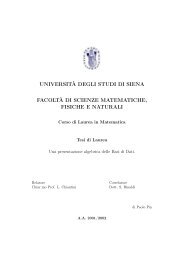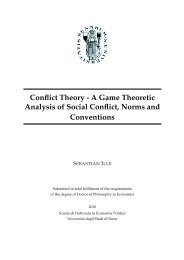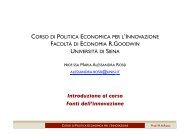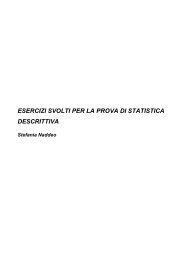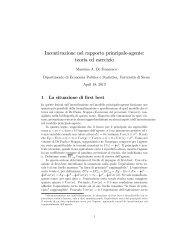Appunti delle lezioni di istituzioni di matematica attuariale per le ...
Appunti delle lezioni di istituzioni di matematica attuariale per le ...
Appunti delle lezioni di istituzioni di matematica attuariale per le ...
You also want an ePaper? Increase the reach of your titles
YUMPU automatically turns print PDFs into web optimized ePapers that Google loves.
fra il livello (a<strong>le</strong>atorio) della prestazione che verrà effettivamente liquidata nel caso si verifichi<br />
l’evento corrispondente e il livello inizia<strong>le</strong> della stessa, noto alla stipula del contratto.<br />
Analogamente il premio puro pagabi<strong>le</strong> in t può essere scritto nella forma<br />
Xt = X0 Φ X (0, t) 1 {Tx>t} ,<br />
con X0 il suo livello inizia<strong>le</strong> e Φ X (0, t) il fattore <strong>di</strong> rivalutazione del premio fra zero e t.<br />
Esempio 6.4.1. In una polizza <strong>di</strong> capita<strong>le</strong> <strong>di</strong>fferito <strong>di</strong> n anni a premio unico, con capita<strong>le</strong><br />
assicurato inizia<strong>le</strong> C0 che rivaluta in modo pieno, la prestazione caso morte è sempre nulla;<br />
<strong>per</strong> t = n, anche la prestazione caso vita è nulla, mentre si ha<br />
Per t = 0 il premio è nullo, mentre<br />
Y v n<br />
n = C0<br />
k=1<br />
(1 + ρk) 1 {Tx>n} .<br />
X0 = U ,<br />
essendo U il premio unico puro del contratto. Tralasciando i casi <strong>di</strong> prestazione nulla, si ha<br />
quin<strong>di</strong> che<br />
e<br />
Y v<br />
0 = C0 ,<br />
Φ Y,v n<br />
(0, n) = (1 + ρk) ,<br />
k=1<br />
X0 = U ,<br />
Φ X (0, 0) = 1 .<br />
Esempio 6.4.2. In una polizza mista a premio annuo costante P , con capita<strong>le</strong> assicurato<br />
inizia<strong>le</strong> C0 che rivaluta secondo la regola degli ennesimi, <strong>le</strong> prestazioni caso morte e caso vita<br />
partono dallo stesso livello Y0 = C0 e rivalutano allo stesso modo. Possiamo al<strong>le</strong>ggerire un<br />
po’ la notazione, omettendo l’apice “v” o “m” nel livello inizia<strong>le</strong> e nel fattore <strong>di</strong> rivalutazione,<br />
che coincidono nei due casi:<br />
Y m<br />
t = Y0 Φ Y (0, t) 1 {t−1n} .<br />
Il fattore <strong>di</strong> rivalutazione è<br />
Φ Y (0, t) = Ct<br />
C0<br />
essendo Ct calcolabi<strong>le</strong> in modo ricorrente secondo la (208). Si verifica facilmente che anche<br />
ΦY (0, t) può essere calcolato in modo ricorrente, come soluzione21 <strong>di</strong><br />
⎧<br />
⎨ Φ Y (0, 0) = 1 ,<br />
⎩ Φ Y (0, t) = Φ Y (0, t − 1) (1 + ρt) −<br />
,<br />
n − t<br />
n ρt ,<br />
(214)<br />
21 Si può <strong>di</strong>mostrare (C. Pacati, Valutazione <strong>di</strong> portafogli <strong>di</strong> polizza vita con rivalutazione agli ennesimi,<br />
Gruppo <strong>di</strong> ricerca su “Modelli <strong>per</strong> la finanza <strong>matematica</strong>”, Working pa<strong>per</strong> 38(apri<strong>le</strong> 2000)) che la soluzione<br />
in forma chiusa dell’equazione ricorrente (214) è<br />
Φ Y (0, t) =<br />
t<br />
t−1 <br />
(1 + ρk) −<br />
k=1<br />
k=0<br />
n − t + k<br />
ρt−k<br />
n<br />
t<br />
(1 + ρj) .<br />
j=t−k+1<br />
c○ C. Pacati 2005, <strong>Appunti</strong> IMAAV, sezione 6 (v. 26/12/2005) pag. 52


